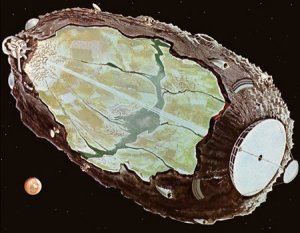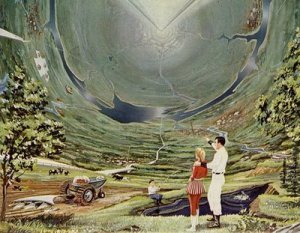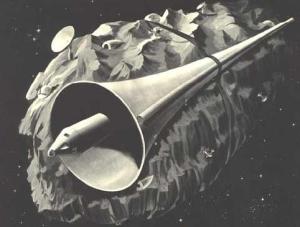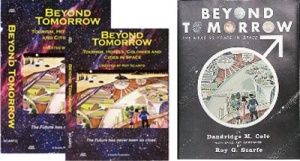Alex,
Great post on Dan Cole, A very dear and missed friend.
Roy

Roy has had a very long and distinguished career as a space artist, writer and futurist. He also coauthored Beyond Tomorrow with Dan Cole. This book is one of the great classics of a whole body of literature devoted to speculation concerning humanity’s future in space and the possibility of creating a spacefaring civilization. I am happy to report that several copies of this book were recently found in pristine condition in a warehouse and are available for purchase courtesy of Roy Scarfo.
I am also honoured that Roy has accepted my invitation to submit a guest blog. So with great pleasure, and a very special thank you to Roy, I would like to present without further delay Roy’s submission to the Discovery-Enterprise.
__________________________________________________________
I have been asked by Alex Bonnici to submit a guest article concerning Dan Cole for the “Discovery Enterprise” blog. I would first refer the readers who are interested in the life of Dandridge Cole to first read two posts on my blog
The Future in Space for a little background.One post is titled ‘
About Dandridge Cole‘ and the other post is ‘Mechanism of Resurrection.’Dan in the early sixties was considered the most futuristic thinker living at the time. Articles on him appeared in most of the prominent magazines and newspapers throughout the world. Our association began at GE’s Space Technology Center in Valley Forge, PA, at the time considered the largest private facility devoted to space research in the world. We were both employees there. We worked on many projects together but it’s hard to remember what they all were. Our major project together was the book “Beyond Tomorrow” published by Amherst Press in 1964. We would meet in the evenings after work in my office at GE and discuss the various chapters one by one, page by page, word by word, for a period of over a year. Our discussions took us to every area of space exploration and life and beyond.
Our work together gave us a handle as “the weird couple” because of the way-out material we were producing together. Today many of those concepts are as common as soap. The majority of our work together was done outside our regular responsibilities at GE, although sometimes they overlapped. We would meet almost daily for lunch at the cafeteria and afterward walk and talk during the rest of our lunch hour. This went on for years.
Our personal lives were usually never discussed, and therefore, I knew little of Dan’s personal life. Last year one of Dan’s daughters from Michigan contacted me wanting to learn more about him since she was very young when he died. We met at our home over lunch at which time we both learned something new about Dan.
One thing in Dan’s life of which he was most proud was his service as a paratrooper with the 597th Airborne Engineers during WWII. He wrote many poems, music and lyrics about his experiences as a paratrooper. One follows:
To My Parachute
Copyright 1944 by Dandridge M. Cole
Lotus blossom drifting
White against
the blue,Hearken while I humbly
Give my thanks to
you.Never was there flower
Half
so fair to see;Never has a maiden
Done so much for
me,As your bloom above me,
While
I’m floating high;Borne by silken panels
Gently
through the sky.When I look above
meAt my panels strong,
My heart fills up with
smiles,Gratitude and song.
There
is not a blossom,Maid, nor setting sun
That compares
in beautyTo you, my pretty
one.Hear me, staunch
protector,Angel Gabriel,
Let me down, but
gently,Do your duty well.
Catch
me as I hurtleToward the ground below;
Jerk my
bruis-ed shoulders…Never let me
go.Gabriel, my angel
Guardian, so
true,May I always find you
White against the
blue.
Roy Scarfo
__________________________________________________________
I was also rather surprised and extremely honoured to receive a comment from Dan Cole’s son Stephen Dandridge Cole:
Thank you for the fine article on my father.
You mention meeting Don Cox and also the idea that it would be good to republish Islands in Space. Are you aware that something of the sort was done? In 1996 Don Cox contacted another old friend of both himself and my father, Jim Chestek, and together they published “Doomsday Asteroid” (admittedly a more sensational title!) Capitalizing on recent interest in and concern about asteroid impacts, it draws on and updates the older book.
And apropos of Mr. Zebrowski’s interesting novel, Macrolife (of which I have an early copy – perhaps I should get the new edition) I might also mention his Sunspacers trilogy and Skylife, which he co-edited. These both also reflect or allude to the realms that my father envisioned.
August 24, 2007 10:48 PM
Thank you, Stephen for your kind words. I did indeed meet Jim Chestek I was sitting next to him during Don Cox’s presentation at the ISDC in New York back in 1996. And, it was he who formally introduced me to Donald Cox.
I have such wonderful memories of that conference.
Alex
I would also like to express a very special thank you to my fellow bloggers Ralph Buttigieg and Dennis Chamberland for choosing my article for our blog’s submission to The Carnival of Space.












